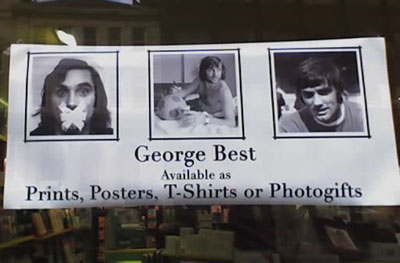
They don’t hang around much in the Finchley Road branch of Snappy Snaps. Dead just 24 hours, and already available as a ‘photogift.’ Tasteful.

They don’t hang around much in the Finchley Road branch of Snappy Snaps. Dead just 24 hours, and already available as a ‘photogift.’ Tasteful.
I like CD Baby. They sell quite a lot of interesting music, and orders are confirmed with a great bit of e-mail marketing.
Your CD has been gently taken from our CD Baby shelves with sterilized contamination-free gloves and placed onto a satin pillow.
A team of 50 employees inspected your CD and polished it to make sure it was in the best possible condition before mailing.
Our packing specialist from Japan lit a candle and a hush fell over the crowd as he put your CD into the finest gold-lined box that money can buy.
We all had a wonderful celebration afterwards and the whole party marched down the street to the post office where the entire town of Portland waved ‘Bon Voyage!’ to your package, on its way to you, in our private CD Baby jet on this day, Thursday, September 1st.
I hope you had a wonderful time shopping at CD Baby. We sure did. Your picture is on our wall as ‘Customer of the Year’. We’re all exhausted but can’t wait for you to come back to CDBABY.COM!!
Lovely. It’s genuinely silly, rather heart-warming, and gives the company an unexpected human face. You tell your friends. Hell, if you’ve got a website, you probably share the e-mail online. As a result, more people talk and read about the company, and they end up with more business, both new and repeat. All because someone spent twenty minutes writing an e-mail instead of two. Great stuff. Perfect viral marketing.
PodZone are a company I know next to nothing about. I’m sure they’re lovely people. They sell an accessory or two I’m considering purchasing. If I did, they’d also send me a confirmation e-mail. It would read as follows:
Your accessories were carefully taken off our shelves with white, kid gloves and placed on a gold, silk cushion.
Our team of 25 highly trained inspectors examined each item carefully to ensure it was it the absolute best condition before we mailed it.
Our packing expert placed your goods into the finest available jewel encrusted box and sealed it with a kiss.
Your box was then rushed to the airport in a specially hired red Ferrari 550 Maranello. (No speed limits were exceeded, by the way).
Our private 747 jumbo jet then took off with your order sitting proudly in seat 1A of First Class and is currently winging its way over to you, super fast!
Back at the office, all of us are having a massive celebration, complete with champagne and chocolate cake! At the party, we voted you CUSTOMER OF THE YEAR! Please send us a picture so we can put it on our wall!
Thank you again for shopping at PodZone – we can’t wait for you to come back so we can throw another party!
Hmmm. Do I detect a small amount of plagiarism at work here? Surely not…
If someone were to ask me what my current favourite cookbooks were, I’d have no trouble answering.
Regular readers will be familiar with my fascination with the first of these, and the spectacular results I’ve hewn from the raw ingredients listed in its hallowed pages. It’s a great book, and the recipes are extremely forgiving. You can’t go wrong. Like eating meat? Then buy it.
The second choice is perhaps less obvious. Cooking using this book is more of an exact science, but with a little preparation, decent ingredients and the right frame of mind, exceptional examples of culinary architecture are within the reach of any half-decent cook.
The best thing about Bourdain’s book, however, is his use of language. While most great chefs are rightly passionate about their craft, this passion rarely comes across in their prose. Watch Gordon Ramsay on TV, and you realise very quickly how much he cares about food, how important he feels it is, how much both good and bad cooking stir his emotions. He’s brilliant. But read his books, and the passion simply isn’t there. The recipes are exceptional, the photos majestic, but there’s no real fire, no animation, no rapture, no spirit. Bourdain has all these in spades.
Here are a few choice quotes:
See? Genius. I like to imagine Bourdain at his station in the kitchen, cigarette dangling casually from lower lip, half-empty bottle of Burgundy to one side, starched uniform covered in blood as he rustles up another batch of mouth-watering cassoulet. Listening to the Ramones, probably. My kind of cook.
But even Bourdain gets it wrong sometimes – witness my recent e-mail to his restaurant.
Hello.
I recently purchased Anthony Bourdain’s Les Halles cookbook, and although there is much to admire in Chef’s spicy prose and no-nonsense approach to life in the kitchen, I must take issue with one of the recipes.
Page 277: 450°F/230°C for 40 minutes? Are you insane? What is it you’re trying to make? Clafoutis or charcoal?
All the best,
Fraser
Ramsay, btw, cooks clafoutis for 20 minutes at 190°C. This is much more sensible.
Les Halles have yet to get back to me. Perhaps I’ll ask again when I eat there next month.
Travelogue over, it’s time for me to get back to what I do best. No, not cooking. Or masturbation. Or even amateur taxidermy. It’s time to start complaining about stuff. One of my regular sources of frustration, the Independent newspaper, are still refusing to publish my letters. Perhaps I’m on some sort of blacklist.
Sir,
Much as I enjoyed John Walsh’s three page advertisement for Dyson (15th November), I must take issue with his statement that the ‘contrarotator’ washing machine is a “huge success”. This product has not been available to purchase for some time, withdrawn because production was unprofitable. I look forward to Walsh promoting the “ever-popular” Sinclair C5 and the “taste sensation” that is Cherry Coke.
Yours,
Fraser
Tomorrow I’ll be complaining about a restaurant even before I’ve eaten there.
I bet you can’t wait.
And then it’s the dash for the border. We’re leaving the country by train, and Mr Lee proudly hands round timetables of international routes from Pyongyang, as if to suggest that boarding a train in, say, Milan or Barcelona, and ending your journey in North Korea, is as easy as catching the Metropolitan line from Baker Street to Regents Park. We’ve been told that a strict ‘no cameras’ rule applies on the railways, and that fellow passengers will report instances of photography to the guards, so the first time on the tour we stop snapping everything that moves.
It’s the best part of a day to Beijing, and different people have different ways of spending the time. Some catch up on much-needed sleep, others head to the dining car to get drunk, getting slowly stewed under the watchful gaze of the two Kims. I’ve done border crossings before in this part of the World, and experience tells me that the last place you want to be with a full bladder is trying to get into China when the train toilets have been locked, so I settle back with a book for the duration.
The journey is mainly uneventful, the border crossing at Sinuiju generating the only real excitement. North Korean border guards board the train first, taking our passports and searching our bags, before we’re let out to stroll along the platform. Beer and snacks are available to purchase from a stand, but there’s little to do except to stare curiously at the locals milling around while they eye us in return.
Back on board, the train grinds it’s way out of Sinuiju, the last few hundred metres of the town cloaked in complete darkness, and creeps onto the Sino-Korean friendship bridge that straddles the Yalu River. From here we can see China, and the difference is immediately apparent – neon everywhere, brilliantly lit skyscrapers, and search beams soaring unnecessarily into the air. It’s as if the Chinese have a message for their cousins across the water: you don’t have enough electricity? Look at us! We have so much we can afford to waste as much as we want!
Chinese border formalities follow – the toilets are locked again, passports are collected, and our temperatures are taken by means of a hand-held contraption pointed at our foreheads, checking for the presence of bird flu. Setting off again, the entire train is disinfected with spray, leaving those of us unlucky enough to be standing next to open windows soaked.
By breakfast time we’re in Beijing. It feels alien after what we’ve been through – busy, noisy, dirty, and completely in-your-face. There are adverts everywhere (in North Korea there’s virtually no advertising, apart from a few billboards extoling the virtues of the Whistle, a car built using Fiat parts in a joint venture with South Korea’s Pyeonghwa Motor Company), and the familiar shop fronts of McDonald’s and Starbucks are omnipresent. There’s obviously nothing for it but to throw ourselves straight back into a western lifestyle, so we head to Steak & Eggs, a restaurant where no amount of pleading will ever prompt a plate of kim’chi or a bowl of dog soup.
And that’s it.
I’ve assembled the majority of the photos I took into a Flickr set, as well as tracking down the stories and photos of several other travellers and compiling the links on a single page alongside some other useful links. Happy reading.
Waking up with a thick head is beginning to become the norm, but there’s another day of sight-seeing in front of us, Mr Lee is already waiting in the hotel foyer, so the hangover is ignored and it’s straight on to the bus. The first stop on today’s whistle-stop tour of Pyongyang’s attractions is the USS Pueblo, an American ‘spy-ship’ captured by the North Koreans in1968. Our guide for the tour is one of the crew-members responsible for the hi-jack, who starts by showing a video relating the story of the incident.

We learn how 82 American crew were held hostage for close to a year, only being released when the US published a full letter of apology. That the US retracted the apology the moment the sailors were freed is not mentioned. We roam the ship, from the communications room where various radio and encryption machines are stamped with plates that say things like ‘Top Secret Prohibited’, to the rear of the boat where a machine gun is primed to spray bullets across the bows of any ships from the US war maniacs or their southern puppet army. Etc.

Did you spill my pint?
More tales of war-mongery follow at the Victorious Fatherland Liberation War Museum, a vast complex where an enormous mural of Kim Il-sung leading the Korean people greets visitors.

Every pair of eyes focused on the great leader.

You don’t see that every day.
Despite the obvious enormity of museum, we’re given the usual brief highlights package – another film, a few rooms demonstrating American deceit, treachery and confession, and a spectacular, three-dimensional, 360° revolving diorama depicting various scenes from the conflict.

The tank in the foreground is real.
Naturally enough, the next stop is the museum shop, featuring shelves full of books and souvenirs to take home. I finally cave in, investing in a little holiday reading matter.

Just as soon as I finish the new Harry Potter…
Back on the bus, we’re taken to the Arch of Triumph, built in 1982 and (as we’re repeatedly told) three meters taller than its more famous Parisienne counterpart. The construction is dedicated to ‘the home return of the Great Leader Kim Il-sung who liberated Korea from Japanese colonialism’. To be honest, there’s not much that this fella didn’t do.

Taller than the one in Paris, honest.
Lunch is served at the non-revolving revolving restaurant atop Pyongyang’s TV tower, from where the three North Korean television stations are broadcast, each packed with shows proclaiming the superiority of the DPRK and the shameful behaviour of her foes. The view is glorious, and we’re handed binoculars with which to examine the city sprawled out below.
 Pyongyang from above, featuring the Arch of Triumph (foreground) and the Ryugyong Hotel (top right).
Pyongyang from above, featuring the Arch of Triumph (foreground) and the Ryugyong Hotel (top right).
For dessert we’re taken to see the Chollima statue, a 46-metre representation of a legendary winged Korean horse capable of riding 400km in a single night. The Chollima movement was inspired by China’s ‘Great Leap Forward’, as Kim Il-sung turned farmland over from individuals to cooperatives, encouraging collectivization and changing the way the entire nation worked. The rapid rate at which this change occurred was referred to as ‘Chollima speed’, and it’s an ethos that lives on today. Want to produce more tractor parts at your factory? Then work at Chollima speed. Not shredding enough cabbage to feed the family? Wielding that knife at Chollima speed is the answer. Obvious.
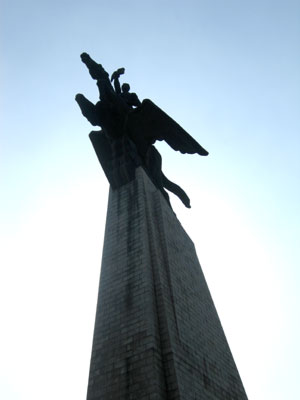
Even faster than Desert Orchid.
As tourists we’re less interested in this history than we are in the more recent propaganda posters next to the statue, and the usual scramble for photos results before Mr Lee quickly shepherds us back on the bus and on towards the next stop.

Have a proper gander at this.
The next stop, as it happens, is the Juche Tower, monument to the guiding philosophy behind North Korea, an ideology formulated by Kim Il-sung (who else?) emphasising self-sufficiency; in a nutshell, that the country can only rely on itself. Juche is such a part of the nation’s fabric that even the calender is affected – this year is locally known as Juche 94, year one marking the birth of Kim in 1912.

Pass the Juche on the left hand side.
At the foot of the statue is a chamber containing stone tablets donated by various DPRK sympathisers and Juche study groups across the globe, oddball organisations like The Ghana National Institute Of The Juche Idea, The United Nations Institute For Namibia Committee Of The Great Juche Idea Of Comrade Kim Il-sung, and the Juche Idea Study Group Of England, based in that hotbed of revolutionary activity, Winchester. We’re taken to the top of the tower via a corridor that smells of sewage and a lift that takes much longer than it ought to to climb the 150 metres to the summit, but the view is again spectacular, overlooking the river to Kim Il-sung square, scene of the previous evening’s marches.
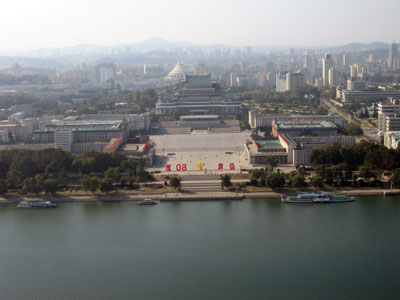
I can see your house from here.
A quick trip across town (by now we seem to be driving in circles) finds us at our next destination, The Monument to the Edification of the Worker’s Party. This splendid erection symbolises the three classes of people who make up the party: peasants (represented by the sickle), workers (a hammer) and intellectuals (a paintbrush).
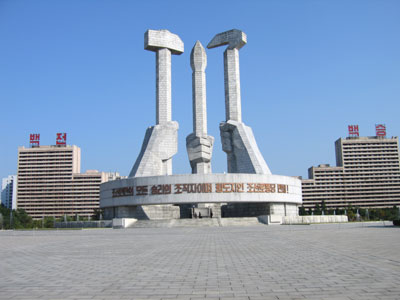
Three classes, three pillars.
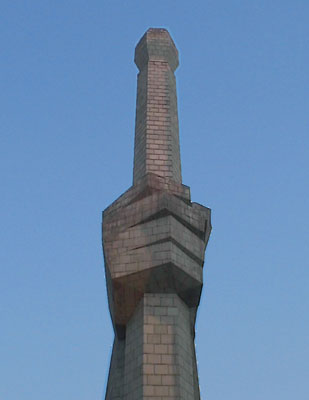
Errr… no comment.
After a quick sojourn to the foreign language bookshop to procure some social-realist posters, we’re finally able to take take photographs of something that, for the more hot-blooded heterosexuals on the tour, has been a continued highlight. With Pyongyang suffering sporadic power outages, traffic lights are shut down during daylight hours, handing control to a team of uniformed girls who spin and whirl and twirl and direct the cars with near-military precision. We’re continually waving at the girls from the window of the bus, but most of the time they remain stern and tight-lipped, only a couple breaking rank and returning greetings. At one point Mr Lee asks what our fascination is with the ‘traffic ladies’. One can only imagine that the novelty wears off after thirty years or so.
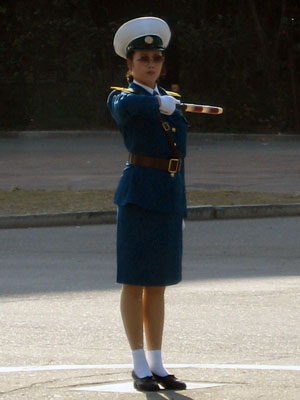
Yowza.
Our final moment of sightseeing is Kim Il-sung Square, 75,000 square metres of granite, where enormous paintings of Marx and Lenin sit side by side, opposite an equally huge portrait of Kim Il-sung adorning the facade of the Korean Central History Museum.
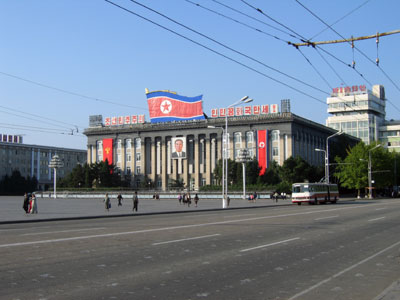
Kim is watching.
One of the more surreal moments of the tour occurs as I stroll across the square, the ridge of my left hand held against my forehead to shield my eyes from the sun. Striding towards me is a soldier from the DPRK army, his eyes showing confusion as he draws near. He stops, eyes me up and down uncertainly, and salutes. I guess it’s a natural reaction, my innocent gesture prompting his automatic reaction. I drop my hand, follow suit, and he moves on, both of us looking startled by this minor confrontation.
At one end of the square young Koreans are seizing a photo opportunity, clambering on board a rather forlorn, moth-eaten replica donkey. I’m wondering if the animal has any special significance, whether Kim Il-sung rode one during one of his tours of the nation, but in the end I think it’s just a donkey. Not everything here means something.

Nice Ass.
Tonight it’s a new hotel, the Yanggakdo. The place feels completely different to the rest of Pyongyang, probably because it sits on an island in the middle of the Taedong River, effectively isolating it from the rest of the city. It’s a bit anarchic after everything else we’ve seen – there’s a nine-hole golf course out front, a ten-pin bowling alley, rumours of a brothel in the basement, and an Egyptian-themed karaoke bar. CBS legend Dan Rather is stalking the corridors with his entourage, and has upset the locals by bringing his own food to eat. The locals, perhaps understandably, have reacted by refusing to talk to him. Once again, the view from my room is splendid.
It’s our last evening in North Korea, and as much as my head tells me that I need an early night, my heart insists on diving into the warren of corridors that run under the hotel to join the rest of the group for one last hurrah. It’s another karaoke bar, and while the number of English-language songs is extremely limited (Old MacDonald has a Farm, anyone?), the alcohol flows freely and the determination to go out with a bang sees everyone in high spirits. Even Mr Lee loosens up, lounging his way through a truly lascivious version of Rod Stewart’s ‘Sailing’, while I seize upon this once in a lifetime opportunity to roll out the falsetto and shriek my clumsy way through the Bee Gees’ ‘How Deep Is Your Love?’. By the end of the evening everyone is much the worse for wear, and before retiring we pose for photos, glasses raised and chanting “D! P! R! K! D! P! R! K!”
To be quite honest, it’s all a bit of a mess.
Read on (exit).
After an early morning breakfast we’re back on the road. It’s one of the most important dates in the North Korean calender, the 60th anniversary of the founding of the Worker’s Revolutionary Party, and all of Kaesong has turned out to pay their respects to yet another statue of Kim Il-sung. This monument towers above the town on the peak of Mt Janam, the Great Leader relaxed in all his bronze magnificence as the multitudes climb the hill to acclaim his Godliness.

As you can see, there’s a lot of pink going on. This is the traditional national dress, called either the chima chogori or the hanbok or the chos’n-ot, depending on which version of the Internet you believe, and I’ve not been able to pinpoint what the colour signifies. Perhaps it’s a love of candy floss. Smaller numbers can be seen wearing fluorescent green, and there’s also a yellow and red version. Either way, these garments would be very handy for cycling in terms of visibility, although I imagine the lengthy hem arrangement might hinder peddling.
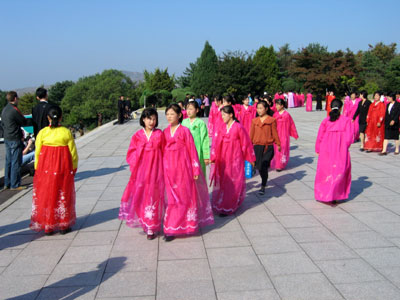
There’s more pink to be had at our next stop, the Koryo Museum, where the guide is adorned in a lighter shade and briskly shows us the exhibits before slowing down at the museum shop where we can spend hard currency. It’s a pattern which will become familiar at most of the places we stop – guided past the exhibits rather than being given time to examine them. The commentaries are similarly uniform – each presented in beautifully flawless yet monotone English, as if endless rehearsal has removed any spontaneity from of the delivery.
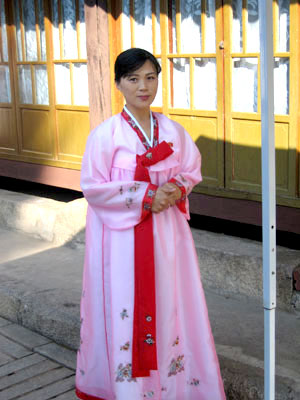
The guide at the Koryo Museum.
Mother of seven children.
Next it’s the Kongmin’s Tomb, a charming set of stone figures and burial mounds marking the final resting place of the 14th Century King of Koryo, his plot carefully guarded by some rather stern-looking stone sheep.

Our guide, Mr Lee, at King Kongmin’s tomb.
Then it’s up the highway to Pyongyang, stopping only for a photo opportunity at The Monument to the Three Charters for National Reunification.

The Monument to the Three Charters for National Reunification.
Heading back into the city we stop briefly at Kim Il-sung’s birthplace, a spotlessly maintained pair of thatched huts showing the Eternal Leader’s humble origins. Once again we’re given the whistle-stop tour before being allowed to settle nearer the cash register.

Kim was here.
Arriving back in the city, we’re driven to Puhung subway station for what turns out to be one of the highlights of the trip. Descending an enormously long elevator (it transports passengers to a vertical depth of 100 metres and takes several minutes to do so), we’re confronted by an enormous cavern hewn out of the rock, cloaked in marble and adorned by a set of extraordinarily ornate chandeliers. On the vast platforms commuters huddle round display copies of the local newspaper, studiously noting the contents, while trains slide quietly in and out of the station.
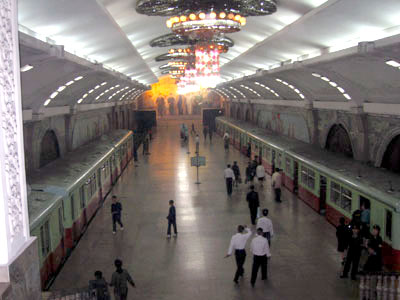
Puhung.
And then we get to ride the train. It’s curious, the only part of the entire tour that feels stage-managed. We’re ushered to one end of the platform, and very quickly a completely empty train pulls up. There’s a moment of confusion, some hand-signals, and the train reverses back into the tunnel. A minute later another arrives, packed with commuters apart from the carriage that arrives in front of us, one end of which is empty. We clamber on, and for a minute or so the middle section of the car plays host to a hilarious battle of international chivalry, North Korea versus the rest of the World. Armed with several languages and a some less-practiced hand gestures, we’re desperate to let the locals sit down, but they won’t have it, insisting that we do. It’s the World’s politest standoff. Eventually we’re all sharing the same space, everyone grinning maniacally and teaching each other to say “hello”. A single stop later (Yongwang station) and we depart amid much waving and more smiling. It’s a glorious, fleeting moment of genuine interaction right in the middle of what had felt like the one truly choreographed part of the trip.
Naturally enough, following this brief breakthrough in armistice negotiations, we’re immediately faced with souvenirs to buy – copies of the Pyongyang Metro Guidebook, a snip at €5 – before being ushered out of the station and into the daylight.

Pyongyang by day.
Lunch is memorable, not so much for the food, but for what follows. The waitresses line up to sing karaoke, starting with Ban Gap Seum Ni Da (Nice To Meet You), a sprightly number from the country’s leading exponent of modern popular music, the Pochonbo Electronic Ensemble. This song is everywhere we go, from the Arirang Games to TV broadcasts – I imagine it’s the local equivalent of “Wonderwall” or “Bohemian Rhapsody”. Another song follows, then a third girl gets up to sing. This tune has a more strident beat, and pretty soon all the Westerners in the room are clapping gleefully along. And then the visuals kick in on the big screen. It’s all missile launches, marching soldiers and mushroom clouds. Christ knows what she’s singing about, but it ain’t Scaramouche, Scaramouche will you do the Fandango. Immediately we’re all exchanging ‘WTF?’ looks and trying not to look like it’s the most surreal moment of our lives, but the atmosphere it the room has just been cranked up several notches.

All eyes on the screen. We’ve stopped clapping.
Tumbling out of the restaurant and onto the bus, it seems that the day can’t possibly develop any further bizarre twists, but we’re wrong. We’re off to a flower exhibition. Normally this would be the signal for me to catch up on a book or, in the absence of reading material, hack off my arm with a blunt fork in a doomed attempt to excuse my presence, but we’re in North Korea, where flower shows are not like those at Kew Gardens. For a start, there are really only two kinds of flower on display.
The first is the Kimilsungia, and the second, for those with limited imagination, is indeed the Kimjongilia>. A red rose and a purple orchid. Millions of them, shaped into endless sculptures demonstrating the strength of the regime and the ideals that are its backbone. It’s extraordinary.

Say it with flowers.
Meanwhile, local families are queuing up to have their pictures taken in front of vast portraits of the two Kims, and those caught up in any kind of green-fingered fervour can purchase ancient looking secateurs with which, one presumes, to produce their own landscaped tributes.
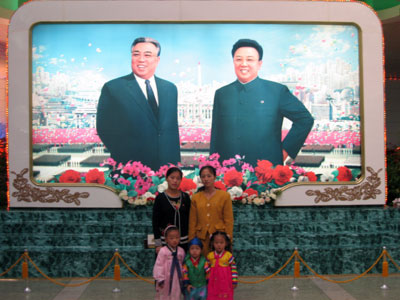
Everybody say “American imperialist aggressors”
As tradition is this part of the World must surely dictate, there’s only one way to follow such an event, and that’s with a trip to the circus. Tightrope-walkers walk tightropes, jugglers juggle and acrobats perform acrobatics. It’s all highly impressive, and there’s not a dancing bear in sight. During one peculiar, pantomime-like sequence, an actor dressed as a drunk American GI staggers into the arena, a North Korean performer sneakily planting repeated kicks to his rear as laughter rains from the stalls.

All the fun of the fair.
As soon as the show is over we’re hurried back onto the bus and ferried across town to the efficiently titled Monument to the Victorious Fatherland Liberation War 1950-1953, a vast stone square surrounded by ten bronze statues depicting various scenes from the Korean War.
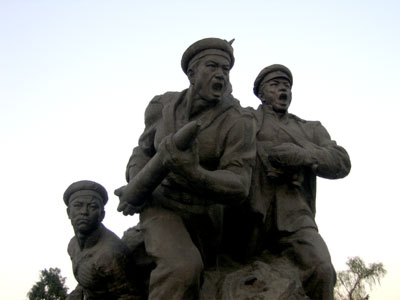
War is stupid. And people are stupid. etc.
From the memorial we’re also afforded a decent view of the 105-storey, 3000-room Ryugyong Hotel, the construction of which started in 1987 and halted five years later. The reason? Depends on who you listen to, but either local investment ran out, foreign investment was withdrawn, or the whole construction was built of such low-grade concrete that it couldn’t ever hope to be safely completed. In 2005 it’s derelict, ghostly and unfinished, topped by a rusting crane.
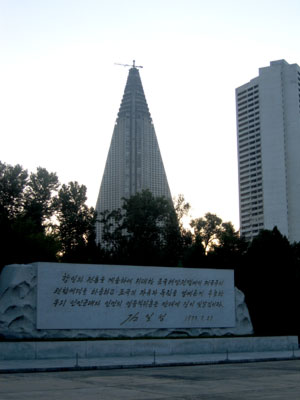
Room service may be some time.
After dropping our bags back at the Koryo Hotel we’re driven across the city once more, this time to sample Korean hot pot, a cook-your-own kind of affair featuring various scraps of meat, vegetables, noodles, egg and tofu. While we’re eating we’re able to watch the highlights of the day’s big parade in Kim Il-sung Square, the camera switching from time to time to shots of Kim Jong-il keeping a close eye on proceedings.

We watch TV, Mr Lee watches us.
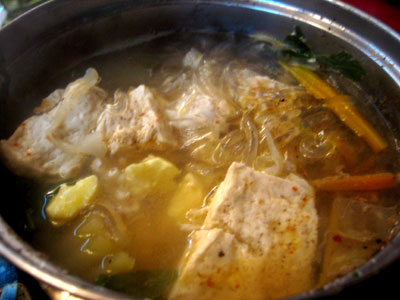
I made this. Sort of.
Before lights out we hit the bar at the hotel, where a fellow traveller is performing what we think is the first concert by an American in North Korea since the cessation of fighting in 1953. This may be historical, but the performance is a little on the meek side overall, although his bravery in picking through a slow version of ‘The Star Spangled Banner’ should probably be applauded. Hendrix at Woodstock it surely ain’t, but it’s briefly entertaining nonetheless, and once again events are listing towards the surreal. Most of the clientele are half-cut, dodgy South Korean businessmen busy hustling travel junkies out of a few bucks on the pool tables, and an order of drinks paid for in Euros prompts a fistful of change that includes American Dollars, Chinese Yuan and a small packet of melon-flavoured chewing gum.
By now, several drinks to the left of sober, this seems perfectly normal.
Read On (day four)